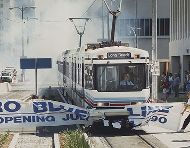Article from: www.thenewspaper.com/news/32/3256.asp
9/9/2010
California: Metro Accident Lawsuit Illustrates Light Rail Danger
Running trains at 55 MPH on the streets of Los Angeles, California caused a fatal collision.
 More and more cities are thinking about installing light rail on city streets as the federal government holds out the prospect of greater subsidies diverted from gasoline tax funds. The California Court of Appeal on August 30 ruled that a lower court erred in throwing out a lawsuit against the city of Los Angeles for negligence in a fatal accident involving a metro Blue Line train. The incident reveals the significant threat high-speed rail can pose when run on streets designed for automobiles.
More and more cities are thinking about installing light rail on city streets as the federal government holds out the prospect of greater subsidies diverted from gasoline tax funds. The California Court of Appeal on August 30 ruled that a lower court erred in throwing out a lawsuit against the city of Los Angeles for negligence in a fatal accident involving a metro Blue Line train. The incident reveals the significant threat high-speed rail can pose when run on streets designed for automobiles.
At 8am on March 1, 2004 Abraham Tovar had been driving with his wife Sara and son Steven when he made a left-hand turn at the intersection at Wilmington Avenue and Willowbrook Avenue East. The turn was illegal, but Abraham Tovar apparently did not see the flashing lights of the gate or hear the bells of the approaching train. Because of a curve in the road, the train operator did not see Tovars' car until it crossed the track. The train hit the vehicle at 55 MPH, hurling it 300 feet while the train braked. Sara Tovar died of her injuries.
The surviving Tovars sued the county's Metropolitan Transportation Authority for negligence, asserting that the Metro system creates a well-known and significant hazard for drivers who were, according to highway safety expert Robert Foster Douglas, frequently confused by inadequate signage warning of the left-turn prohibition. As a result, such turns into the train's path are common. The lower court judge suppressed this evidence.
"Plaintiffs proffered videotaped evidence of motorists turning left at the Willowbrook-Wilmington intersection which showed that the condition of public property at that intersection increased the risk of such turns or permitted motorists to make such turns," Court of Appeal Justice Patti S. Kitching wrote. "That the turns on the videotape did not result in accidents did not make the evidence of such turns irrelevant to the determination of whether the intersection was a dangerous condition of public property. That videotaped evidence should have been admitted."
Accident reconstruction expert James Sobek testified that of 500 intersections he has examined, this is the second most dangerous of all with ten times the expected rate of collisions. The appeals court ruled that the trial court was wrong to suppress this evidence as well.
The Tovars, however, lost on other aspects of their suit. The city did make engineering changes to improve safety at the intersection, but state law specifically protects municipalities from allowing this fact to be admitted as evidence of prior negligence. The appellate court did not believe the Tovars met their burden of proof about the inherent danger of the intersection in question.
"The defects alleged by plaintiffs were poorly placed or missing signs, ambiguous or inconspicuous striping on street pavements, a center median that did not physically prevent a left-turning driver from crossing the tracks, and a failure to provide closing gates at the intersection of Wilmington and Willowbrook, all of which alleged defects were on property owned by the city, not by the MTA," Kitching wrote. The order granting the MTA's motion for nonsuit as to dangerous condition of public property is affirmed."
Overall, however, the Tovars won a victory.
"We conclude that the evidentiary rulings prevented plaintiffs from presenting evidence important to their cause of action for dangerous condition of public property as to the city, and we reverse the judgment in favor of the city," Kitching concluded.
A copy of the decision is available in a 200k PDF file at the source link below.
Source: Tovar v. Los Angeles County MTA (Court of Appeal, State of California, 8/30/2010)
Permanent Link for this item
Return to Front Page
 More and more cities are thinking about installing light rail on city streets as the federal government holds out the prospect of greater subsidies diverted from gasoline tax funds. The California Court of Appeal on August 30 ruled that a lower court erred in throwing out a lawsuit against the city of Los Angeles for negligence in a fatal accident involving a metro Blue Line train. The incident reveals the significant threat high-speed rail can pose when run on streets designed for automobiles.
More and more cities are thinking about installing light rail on city streets as the federal government holds out the prospect of greater subsidies diverted from gasoline tax funds. The California Court of Appeal on August 30 ruled that a lower court erred in throwing out a lawsuit against the city of Los Angeles for negligence in a fatal accident involving a metro Blue Line train. The incident reveals the significant threat high-speed rail can pose when run on streets designed for automobiles.